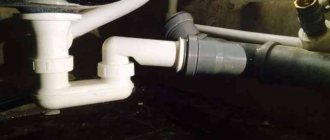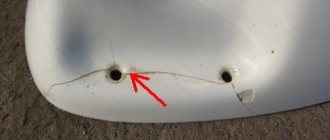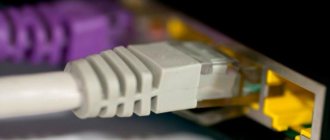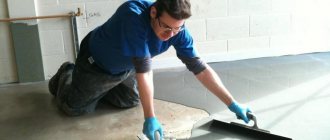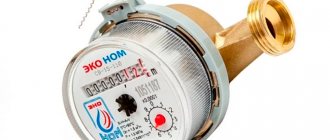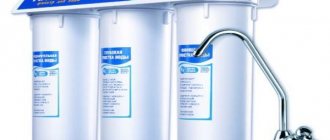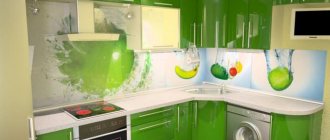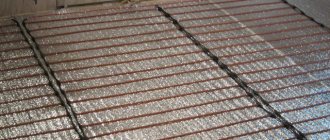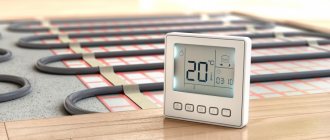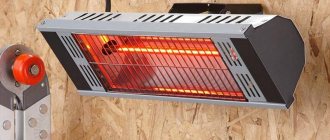↑ 1. Operating principle
The piping (or drain-overflow) organizes the drainage of water from the bathroom tank into the sewer pipe. The device consists of several hoses and tubes that are connected to each other, with a sewer system and two bath openings. The top hole of the tank prevents water from overflowing, the bottom hole is responsible for draining.
If all components are installed correctly, the likelihood of overflowing the bathtub is reduced to a minimum, but there must be moderation in everything. Sometimes water fills the bowl faster than it drains, in which case you can flood the floor in the room.
First we choose the design of the siphon for the bathroom, and then the design
The familiar one is gradually disappearing from our homes, since modern devices allow us to open the water drain with one movement, rather than pulling out a rubber stopper by a chain. Especially when the bathtub is filled with hot water and the plug is firmly in place. Agree, this is very convenient. Therefore, we will not consider the familiar design of pulling out the cork. Let's focus on those that are the future. Of course, indicating the pros and cons of each device (after all, this is what the “Tips from an Experienced Plumber” blog is for). Today in plumbing stores
↑ 2. Types and differences of devices
↑ 2.1 Standard version
Model complete set:
- Pipe (siphon). Serves as a barrier against unwanted odors entering the apartment;
- Overflow neck;
- Drain neck;
- A tube connecting the siphon to the sewer system;
- A corrugated hose that allows water to flow into a siphon.
↑
This device is considered traditional. To fill the bathtub, close the bottom hole with a stopper.
During operation, you need to monitor the condition of the seals and replace them in a timely manner.
Price range for standard models: from 10 to 25 $.
↑ 2.2 Semi-automatic drain and overflow
This system is more advanced than the traditional one. The drain and overflow consists of tubes and hoses that drain water, a siphon, and necks, but there are differences. The semi-automatic machine is supplemented with the following elements:
- Valve plug;
- A special cable that is responsible for controlling the plug;
- The mechanism by which the plug is lowered and raised. This function can be performed by a rotary ring, a button, a valve, or a handle.
The mechanism of action is quite simple: when the cable is tensioned, the valve rises, and due to loosening, it lowers. In order for the cable to move, you need to turn the valve or press a special button. In the semi-automatic device, the overflow hole is hidden behind the control unit. The advantages of the drain and overflow also include the design and ease of use of the structure.
The disadvantage of a semi-automatic system is the degree of reliability. It is better to purchase an expensive modification, or opt for a standard model.
Prices for semi-automatic devices: from 20 to 55 $.
↑ 2.3 Automatic option
A distinctive feature of this mechanism is the valve, the action of which is automated. In order for the plug to close the drain hole in the bowl, you need to press on it. The spring compresses and lowers the valve; due to the latch, the position is maintained. In order to drain the water you need to press the button. Advantages:
- The drain can be controlled with your feet;
- Compact size of the visible part;
- Large assortment of buttons. Chrome elements are suitable for high-tech style; brass buttons will perfectly complement the vintage design.
Automatic drainage is often found in baby bath models. This device simplifies operation; the tank does not need to be turned over to remove water.
The disadvantage of this bathroom waste and overflow option is that it is difficult to replace the button. If the valve breaks, you have to purchase a new system. That is why experts recommend purchasing the most reliable automation.
Prices range on average from $60 to $280.
Automatic drains and overflows
AlcaPlast A504KM
An excellent model that is distinguished by high-quality workmanship and a long service life. Drain diameter - 52 mm. The main components are made of brass and stainless steel. A special feature of the equipment is the ability to adjust the height, which greatly simplifies installation operations. The diameter of the metal plug is 70 mm. The grille is made of high-quality alloy, which shows high resistance to corrosion.
The average price is 2,850 rubles.
AlcaPlast A504KM
Advantages:
- Optimal price;
- Convenient control;
- Efficiency;
- Durability;
- Quick drain;
- Easy connection.
Flaws:
- Not found.
Timo 8004 Chrome
An automatic model, distinguished by its beautiful appearance and high price. The diameter of the hole for connecting to the sewer pipe is 4 cm. Thanks to this device, it will be easier to control the water level in the bathroom, and the original design will add attractiveness to the room. The body is made of chrome-plated brass, which shows high resistance to high temperatures and household chemicals.
The average price is 4,700 rubles.
Timo 8004 Chrome
Advantages:
- External execution;
- High service life;
- Made from wear-resistant materials;
- Universal connection sizes;
- Withstands aggressive substances;
- 5 years warranty.
Flaws:
- Not found.
Ravak X01472
An expensive option designed for users who put quality above all else. Despite the standard external design, the manufacturer approached the selection of the main elements responsibly. Therefore, the product is made of high-quality materials that retain a pleasant appearance for ten years of use.
The average price is 4,200 rubles.
Ravak X01472
Advantages:
- Convenient operation;
- Quick drain;
- The presence of a water seal;
- Metal elements are made of brass;
- Long service life.
Flaws:
- Not detected.
↑ 3. Types and features of materials
The main condition when choosing a material is corrosion resistance. These options include:
- Ferrous metal is a reliable material. The main drawback is the appearance of the device. Currently, they are trying to choose more modern options;
- Plastic for plumbing fixtures (polypropylene). White color, laconic shape, long service life. Polypropylene is inferior to metal in terms of strength, so there is a risk of product breakage. A simple drain and overflow design may be inappropriate if the decoration of the room involves the use of expensive materials and equipment;
- Bronze, brass or copper. Often these non-ferrous metals are not used without a protective layer. Parts located in the visible area can be coated with nickel or chromium (using the electroplating method). The use of nickel is preferable; this material is characterized by long-term operation. The visual difference of nickel is the blue tint of the parts;
In order to determine the type of metal, you should pay attention to the holes in the top and bottom of the bath. The color of copper is red; the strength characteristics of copper are inferior to other materials. Brass is stronger than copper and has a light yellow tint. The bronze base is the most durable in this category, comparable in stability to ferrous metal. Bronze is characterized by a dark brown tone; the main components of the alloy are zinc and copper. Non-ferrous metals are an excellent option for the production of plumbing fixtures. Due to the resistance to corrosion, the parts are easily connected by thread.
Be careful not to damage the protective coating of the base. Even a small scratch will cause the destruction of the entire layer in the shortest possible time. The reason for this effect is a chemical process between metals.
Popular manufacturers of flush-overflow systems
Among the companies that offer a range of different types of plumbing products are:
- Aniplast is a well-known Russian company whose products are of good quality and affordable price;
- Alkaplast is a Czech company that produces budget siphons with automatic lifting of the drain plug;
- Hansgrohe is a well-known German brand that produces high-quality expensive plumbing fixtures, including fittings;
- Jimten is a Spanish manufacturer specializing in plastic products. The products are distinguished by excellent performance characteristics and attractive design.
In specialized stores you can find products from other companies - domestic and foreign.
↑ 4. Installation
You can install the drain and overflow yourself, but it is important not to forget that the tightness of the bathtub in the future depends on the quality of the work. However, despite all the responsibility, installation of the system can be carried out by a non-professional; you just need to listen to the advice of specialists.
↑ General recommendations:
- Follow a certain sequence in your work;
- Use special sealants to process connections;
- When tightening parts, be careful not to strip the threads;
- All elements must be tightened one quarter of a full turn after hand tightening;
- If you cannot tighten the connection, you need to check whether the nut is level.
Installation begins after the bowl is secured to the support. The bathtub must be leveled and fixed. It is also necessary to leave a height gap between the floor and the tank (from 150 mm or more).
↑ Correct sequence:
- The bottom hole of the bathtub is connected to a tee. In this case, you need to process the connection using a sealant and secure the elements with a screw;
- Next, attach the siphon and secure it with the tee outlet with a nut. A rubber cuff can be used as a seal here;
- The overflow neck is connected to a side curved tube (siphon);
- The process is completed by connecting the siphon to the sewer pipe. For this purpose, a special spout pipe is used;
- During each connection, you should remember to lay the seal.
After installation is complete, you need to check the bathtub for leaks. The bowl is filled with water, then you need to carefully examine all the joints and connections. If drops appear on the surface, tighten the elements more tightly and re-treat with sealant.
Siphon installation video:
Installing a piping system on a bathtub
In order to mount the device, you need to purchase the device from a specialized store, as well as stock up on tools, the set of which may differ depending on the type of harness chosen.
Tools required to install the harness:
- To install a cast iron or steel siphon you will need a grinder with a cutting wheel (can be replaced with a narrow blade for metal of good strength) and a hammer.
- When installing an automatic device, you need to stock up on a small flat-head screwdriver, as well as a set of hexagons.
In addition, you need two screwdrivers (Phillips, flat), pliers, silicone sealant and cotton napkins.
Dismantling of old equipment
The work should be done in several stages:
- The first step is to thoroughly rinse and clean the outer layer of the bathtub, and then begin dismantling the old device.
- The outdated plastic siphon is unscrewed using pliers, and the overflow is removed with the same tool.
- The cast iron trim is removed using a grinder, into which you need to insert a 115 mm disc. The work is done in a circle, in sectors.
- After this, you should drive a flat-head screwdriver to pick up and remove the upper part of the old siphon adjacent to the bathtub.
The same manipulations (unscrewing or sawing) should be carried out with the overflow. Then you need to take a hammer and use it to try to loosen the siphon, and then pull it out of the sewer pipe.
Before installing a new system, you need to get rid of the old one. The most difficult thing to remove is old cast iron equipment: this can only be done with a grinder and a hammer
If you have difficulties with rusted bolts, you can use improvised means: a kitchen knife or a bottle opener. With these devices it is quite possible to cut the stainless steel and remove the lid covering the drain hole.
Dismantling the automatic system is quite simple. First of all, remove the plug and unscrew the mounting bolt with pliers or a wrench. To remove the overflow bolt, you need to unscrew the wing with a small flathead screwdriver. Having removed it, you need to unscrew the bolt and dismantle the entire structure without any problems.
Installation of a conventional bathtub trim
Assembly begins with the bottom gasket, which must be found in the kit (it is thicker than the top one). This part is coated with silicone and then put in place.
This is done in the following way: one hand slips the element under the bathtub from below, the other picks it up from above, tucking it into the hole.
First of all, you need to unpack devices purchased in stores, check their completeness, the quality of the products, and also carefully read the instructions. After this you can start assembling
The lower counter part is installed from below, while the overflow mesh with a connected bolt is inserted from above. The structure is carefully tightened with a flat screwdriver. Movements should be made clockwise.
After this, it is important to find the upper overflow in the kit and disassemble it. To facilitate the installation of this important part, a silicone layer is applied to the gasket seat, so that the part will not fall off during installation.
A thin gasket is attached along the diameter of the seat circumference, which also needs to be coated with silicone to improve moisture resistance.
After this, a small corrugated tube is taken, which is slightly stretched, and then alternately put on the nut and the cone gasket - the wide side should be adjacent to the nut.
The corrugated structure is installed in its proper place and secured with a flat-head screwdriver. In this case, you should pull it slightly with two fingers, but this should be done carefully so as not to damage the plastic part. The bolt is first held with your fingers and then tightened with a screwdriver.
If the nut falls out, you can slip a piece of a bag inside or use other methods. The edge of the thin overflow corrugation is inserted into the drain hole, after which the plastic nut is tightened.
Assembling a new water seal (siphon)
The water seal serves to eliminate odors. It is easier to assemble it separately before connecting it to the rest of the parts. One end of it is attached to the drain hole, the other - to the outlet corrugation. The corrugation, in turn, is inserted into the sewer drain hole.
Having completed the installation of the water seal, you should insert the edge of the corrugation into the sewer, and only then attach it to the siphon. Finally, it is necessary to adjust the position of the outlet and tighten all the nuts as much as possible
To check the quality of the assembly, just turn on the water and let it flow down the drain. If there are no leaks, the installation was completed correctly.
Step-by-step instructions for installing a siphon on a bathtub are given in this article.
Automatic fixture installation
Installation of the automatic siphon is carried out similarly to the procedure described above.
- First of all, you need to open the package and find the gasket that will be installed on the drain.
- Align it with the hole in the bathroom, so that the thinner part is at the top. If the siphon is installed on cast iron plumbing, it is advisable to cover it from the inside with plumbing sealant.
- Unscrew the chrome-plated pressing front part from the overflow.
- The place where the gasket fits in a circle is treated with silicone to improve the strength of the connection. In addition, the gasket mounted on the sealant will not fall or move out of place, which simplifies installation.
- The resulting structure is pushed onto the overflow hole with one hand from the outside of the bath, while the pressing chrome part is screwed on with the other hand.
- The next stage is the lamb, which needs to be carefully placed on the rod. After installing the element, tighten the nut with a small flat-head screwdriver. This must be done with maximum caution so as not to damage the part.
- After this, it is important to start draining. The lower part of the structure is brought to the hole, while a drain mesh with a bolt is inserted on top, which we hold with our fingers. The connection is carefully tightened.
- Next, you should try on the plug with the adjusting bolt. To do this, you need to insert the drain mesh into the hole of the clamping bolt and tighten it if necessary. After this, the lock nut is adjusted, which should drop to the bottom mark and then rise again.
To complete the work, a gasket and nut are inserted into the water seal part; The mating part of the drain is installed and the nut is secured. A sewer pipe or corrugation with a diameter of 40 mm is connected to the counterpart of the siphon.
Having installed the automatic piping for the bathtub, you should conduct a test run to check its reliability.
The bathtub is filled to the brim with water, which is then drained. If there is a leak, it is necessary to tighten the elements. If the leak continues, all parts will have to be disassembled and then carefully reassembled
You can also seal the problem area with silicone, but this process is not recommended for the trim that sits between the water seal and the top of the tub.
After installing the drain and overflow, connecting the plumbing to the sewer and water supply, you can build a screen for the bathroom, providing access to the piping elements.
↑ 5. Care tips
There are no strict rules for operating the drain and overflow. Let's look at some tips for caring for this system:
- For automatic and semi-automatic devices, it is necessary to periodically process the parts to maintain the shine of the metal. Such care is carried out using glass cleaners or special products;
- Carry out regular inspections to identify possible leaks;
- If the seal is broken, you can replace the sealing material, or tighten the junction of the elements additionally;
- Siphon clogging is considered one of the most common problems in the operation of this system. Cleaning is carried out with a small brush attached to a wire or using a plunger;
- An alternative to mechanical cleaning is chemical treatment using special means. The alkali in such products helps neutralize the blockage due to its splitting effect;
- These measures can be applied not only to the problem of blockage. The best way to prevent such a problem is periodic maintenance of the system.
Completion
I hope that my experience will be useful to the dear reader. The video in this article will help you learn more about which bathtub trim can be used in your home. I look forward to your additions and comments. Good luck, comrades!
Did you like the article? Subscribe to our Yandex.Zen channel
August 25, 2021
Bathroom, Sewage equipment, Siphon
If you want to express gratitude, add a clarification or objection, or ask the author something, add a comment or say thank you!
